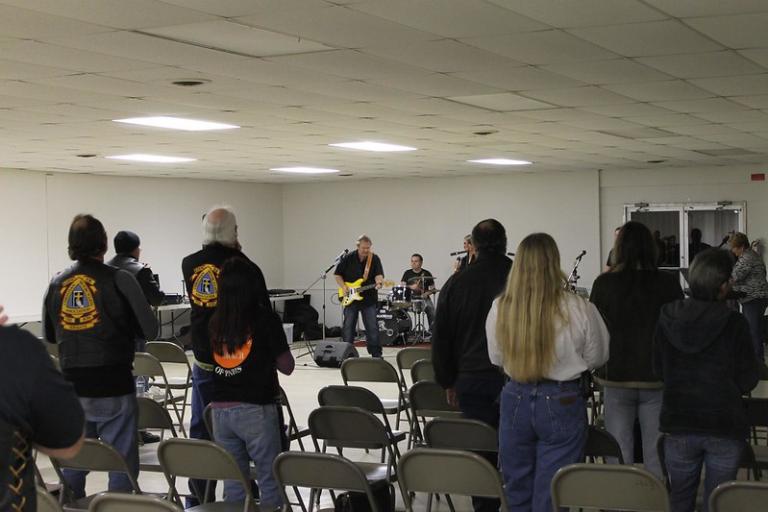The Church Growth Movement of a few decades ago promoted the use of marketing techniques to attract as many people as possible to form a “mega-church.” But today’s marketing philosophy, enabled by online technology, focuses not on reaching vast numbers but on identifying individuals with highly specific interests and targeting them with tailor-made appeals. So the Church Growth Movement is now trying to adapt the “niche marketing” approach by creating not “mega-” but “micro-churches.”
These are not to be confused with small traditional congregations. Micro-churches are built around their targets’ common interests. Where I live, I have seen Cowboy churches and Biker churches. But, it turns out, the possibilities go far beyond those: Warrior Church. Taco Church. Coloring Church.
Christianity Today has published an approving article on the trend. From Kara Bettis, Carving Out a Niche for Micro-Congregations:
On any given Sunday at 7:30 a.m., a visitor to Schlitte Boxing & Fitness may find two dozen or so men and women hitting punching bags, cranking out pushups, or congratulating one another after a particularly tough bench press. It’s not CrossFit. It’s Sunday morning worship at Warrior Church.
To the side of the gym, there’s a stack of milk crates that form a makeshift altar. Before the workout starts, Sean Steele, founder of Warrior Church, kicks off the hour with a 15-minute prayer and discussion from a lectionary. Founded in 2017, Warrior Church is one of four—soon to be six—communities aimed at military veterans and others experiencing trauma that help compose the network of St. Isidore Episcopal Church in and around Spring, Texas.
The St. Isidore network also includes—along with a few house churches—Taco Church, where men gather for prayer at Taco Bell, and Coloring Church, dedicated to “dialogue and artistic expression.” But if you’re hoping to visit St. Isidore’s main building to attend their gathered Sunday service, you will be disappointed. These gatherings aren’t just small groups and outreach programs; they are the church’s primary venues. According to its website, St. Isidore is “a church without walls.”. . .
Leaders of these gatherings feel that the attractional model, in which churches use outreach programs to draw visitors to their Sunday morning services, is less effective in a secularizing culture. Instead of assuming visitors will voluntarily walk through their doors, these leaders take a proactive stance by starting smaller, localized communities where unchurched people live and work.
Reggie McNeal, missional leadership specialist for Leadership Network, views these contextualized communities as a “harbinger that something really big is underfoot” that will undo the Western church’s “single modality church expression” in the congregational model.
What do you think of this? Do any of you have any experience with these sorts of churches?
Though there may be some cases that justify a congregation tailored to specific groups–for example, the deaf, or particular language groups, or a chaplain’s services on a military base–in general, I do not approve.
Both Micro-Churches and Mega-Churches share the Church Growth technique that the founder of the movement, Donald McGavran brought from the mission field: the homogenous unit principle. That is, the notion that, in the words of the Wikipedia article, “individuals are more likely to convert to Christianity en masse when they share similar demographics.”
Whether you have a big group of middle class white suburbanites with families, or small groups of Cowboys, Bikers, Weightlifters, or Colorers, the congregation will consist of similar people who do similar things.
Whereas traditional congregations typically consist of elderly folks, young families, and children; people of all income levels and social classes; individuals with different interests, educational backgrounds, and vocations. (Also, historically, people of different ethnicities, though American congregations need to work on that.)
This is in accord with the Biblical principle that the Church is a unity of diverse individuals, as different from each other as eyes and ears and hands:
12 For just as the body is one and has many members, and all the members of the body, though many, are one body, so it is with Christ. 13 For in one Spirit we were all baptized into one body—Jews or Greeks, slaves[d] or free—and all were made to drink of one Spirit.
14 For the body does not consist of one member but of many. 15 If the foot should say, “Because I am not a hand, I do not belong to the body,” that would not make it any less a part of the body. 16 And if the ear should say, “Because I am not an eye, I do not belong to the body,” that would not make it any less a part of the body. 17 If the whole body were an eye, where would be the sense of hearing? If the whole body were an ear, where would be the sense of smell? 18 But as it is, God arranged the members in the body, each one of them, as he chose. 19 If all were a single member, where would the body be? 20 As it is, there are many parts,[e] yet one body.
21 The eye cannot say to the hand, “I have no need of you,” nor again the head to the feet, “I have no need of you.” 22 On the contrary, the parts of the body that seem to be weaker are indispensable, 23 and on those parts of the body that we think less honorable we bestow the greater honor, and our unpresentable parts are treated with greater modesty, 24 which our more presentable parts do not require. But God has so composed the body, giving greater honor to the part that lacked it, 25 that there may be no division in the body, but that the members may have the same care for one another. 26 If one member suffers, all suffer together; if one member is honored, all rejoice together.
27 Now you are the body of Christ and individually members of it. (1 Corinthians 12)
Also the Bible says much about evangelism, grace, the Gospel, the means of grace. But I don’t see anything in there about marketing.
Photo: Northeast Texas Biker Church Paris Texas by Amy Claxton via Flickr, Creative Commons License













